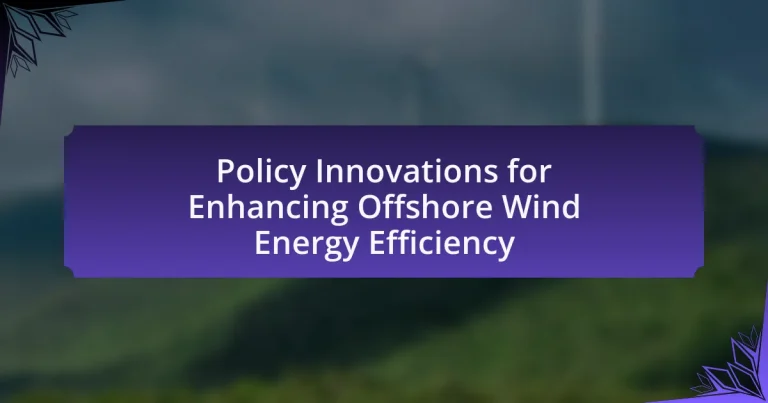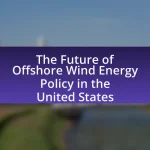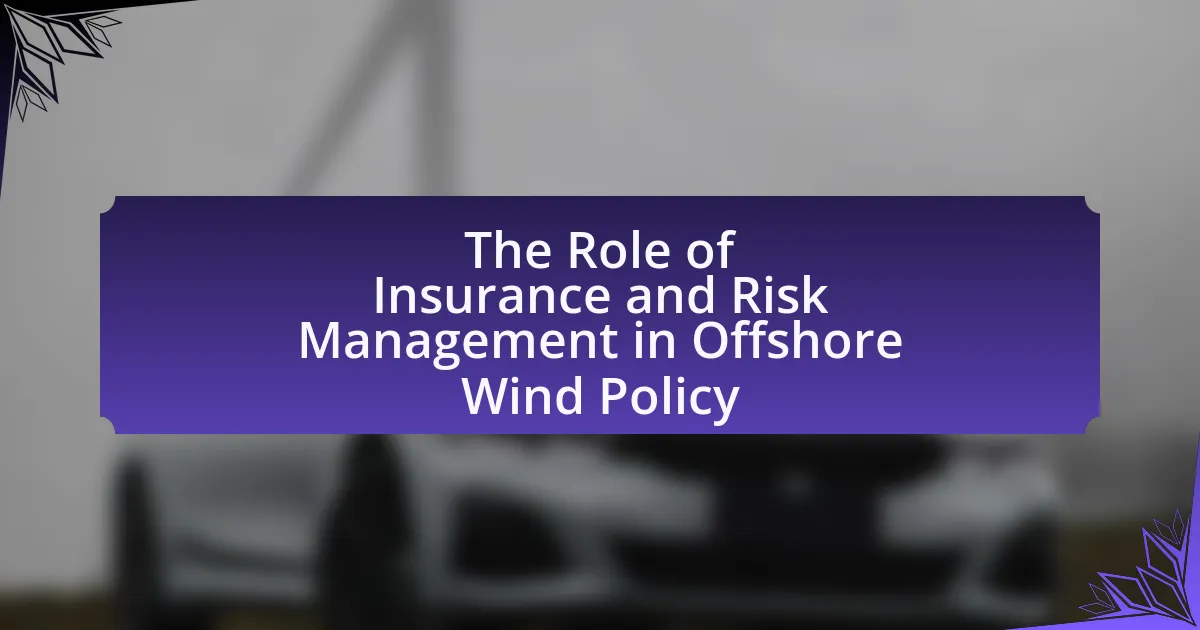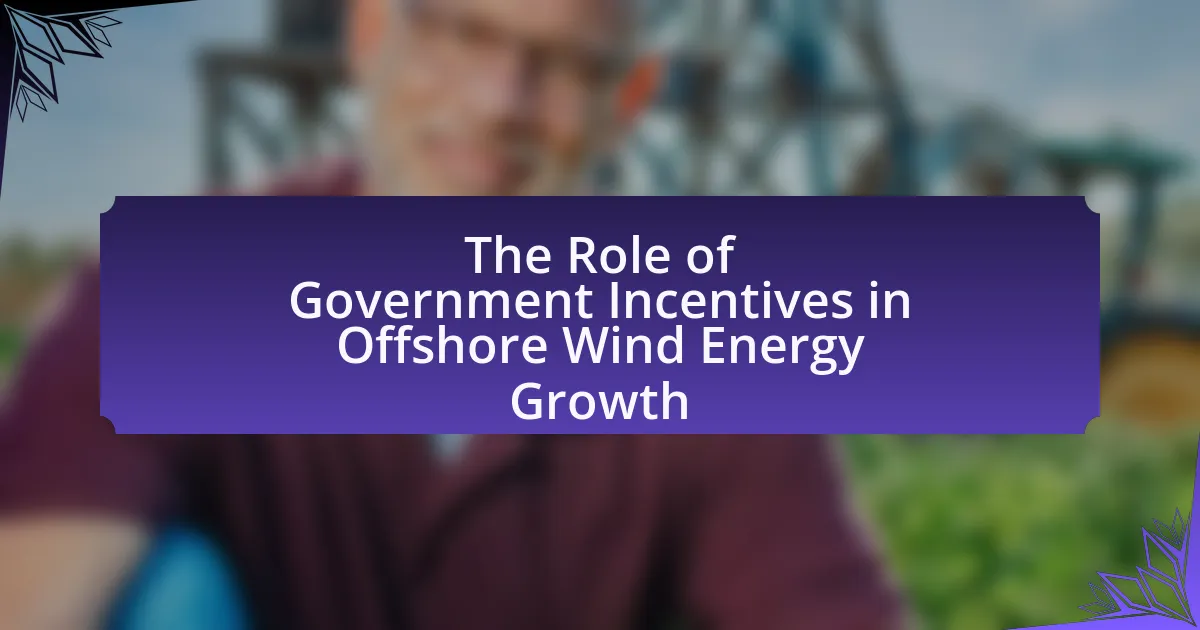The article focuses on policy innovations aimed at enhancing offshore wind energy efficiency. It outlines key strategies such as streamlined permitting processes, financial incentives for research and development, and the establishment of offshore wind energy zones, which collectively facilitate faster project deployment and increased investment in innovative technologies. The discussion includes the impact of these policies on offshore wind energy development across different regions, the environmental and economic benefits of improved efficiency, and the challenges policymakers face in implementing these innovations. Additionally, it highlights successful case studies and best practices that can guide future policy initiatives in the offshore wind sector.
What are Policy Innovations for Enhancing Offshore Wind Energy Efficiency?
Policy innovations for enhancing offshore wind energy efficiency include streamlined permitting processes, financial incentives for research and development, and the establishment of offshore wind energy zones. Streamlined permitting reduces the time and complexity involved in project approvals, facilitating faster deployment of wind farms. Financial incentives, such as tax credits or grants, encourage investment in innovative technologies that improve turbine performance and energy output. The establishment of designated offshore wind energy zones helps to minimize conflicts with other maritime activities and optimizes site selection for wind farms, ultimately leading to increased efficiency and reduced costs. These innovations are supported by data indicating that countries with proactive policies in these areas have seen significant growth in offshore wind capacity, such as the United Kingdom, which has become a leader in offshore wind energy deployment.
How do these policy innovations impact offshore wind energy development?
Policy innovations significantly enhance offshore wind energy development by streamlining regulatory processes and providing financial incentives. These innovations, such as simplified permitting and increased funding for research and development, reduce barriers to entry for new projects. For instance, the U.S. government has implemented initiatives like the Inflation Reduction Act, which offers tax credits for offshore wind projects, thereby encouraging investment and accelerating deployment. Additionally, countries like Denmark have established clear frameworks for public-private partnerships, facilitating collaboration that leads to more efficient project execution. These measures collectively contribute to a more robust offshore wind energy sector, evidenced by the rapid increase in installed capacity globally, which reached over 35 gigawatts in 2022, according to the Global Wind Energy Council.
What specific policies have been implemented to enhance efficiency?
Specific policies implemented to enhance efficiency in offshore wind energy include streamlined permitting processes, investment in research and development, and the establishment of standardized grid connections. Streamlined permitting processes reduce the time and complexity involved in project approvals, allowing for faster deployment of wind farms. Investment in research and development focuses on improving turbine technology and operational practices, which can lead to higher energy output and lower costs. Standardized grid connections facilitate easier integration of offshore wind energy into existing power systems, enhancing overall efficiency. These policies collectively aim to optimize the deployment and operation of offshore wind energy projects, contributing to increased efficiency in the sector.
How do these policies compare across different regions?
Policies for enhancing offshore wind energy efficiency vary significantly across regions, reflecting differences in regulatory frameworks, financial incentives, and technological advancements. For instance, Europe, particularly countries like Denmark and Germany, has established comprehensive support mechanisms, including feed-in tariffs and auction systems, which have led to substantial investments and rapid deployment of offshore wind farms. In contrast, the United States has seen a more fragmented approach, with states like Massachusetts and New York implementing aggressive targets and incentives, while federal policies have been slower to evolve, impacting the overall growth rate of offshore wind capacity. Additionally, Asia, particularly China, has rapidly expanded its offshore wind sector through substantial government investment and streamlined permitting processes, resulting in the largest installed capacity globally. These regional differences highlight how local policies can significantly influence the pace and scale of offshore wind energy development.
Why is enhancing offshore wind energy efficiency important?
Enhancing offshore wind energy efficiency is important because it maximizes energy output while minimizing costs and environmental impact. Increased efficiency leads to higher electricity generation from the same wind resources, which is crucial for meeting global energy demands and reducing reliance on fossil fuels. For instance, according to the International Renewable Energy Agency, improving offshore wind turbine efficiency can increase energy production by up to 30%, significantly contributing to renewable energy targets and climate goals.
What environmental benefits arise from increased efficiency?
Increased efficiency in offshore wind energy leads to significant environmental benefits, including reduced greenhouse gas emissions and minimized habitat disruption. By optimizing energy production, offshore wind farms can generate more electricity with fewer resources, thereby decreasing reliance on fossil fuels, which are major contributors to climate change. For instance, a study by the National Renewable Energy Laboratory found that enhancing wind energy efficiency can reduce carbon dioxide emissions by up to 30% compared to traditional energy sources. Additionally, improved efficiency can lead to smaller physical footprints for wind installations, which helps preserve marine ecosystems and biodiversity.
How does efficiency impact the economic viability of offshore wind projects?
Efficiency significantly impacts the economic viability of offshore wind projects by directly influencing their cost-effectiveness and energy output. Higher efficiency in turbine design and operation leads to increased energy generation per unit of investment, reducing the levelized cost of electricity (LCOE). For instance, advancements in turbine technology have resulted in larger rotor diameters and higher capacity factors, which can enhance energy production by up to 50% compared to older models. This increase in output allows projects to recover initial investments more quickly and improves profitability, making them more attractive to investors. Additionally, efficient operations minimize maintenance costs and downtime, further enhancing the financial sustainability of offshore wind projects.
What challenges do policymakers face in implementing these innovations?
Policymakers face significant challenges in implementing innovations for enhancing offshore wind energy efficiency, primarily due to regulatory hurdles, funding limitations, and technological integration issues. Regulatory frameworks often lag behind technological advancements, creating a mismatch that complicates the approval and deployment of new technologies. Additionally, securing adequate funding for large-scale offshore wind projects is difficult, as these initiatives require substantial upfront investment and long-term financial commitments. Furthermore, integrating innovative technologies into existing energy systems poses technical challenges, including grid compatibility and infrastructure upgrades. These factors collectively hinder the effective implementation of policies aimed at improving offshore wind energy efficiency.
How do regulatory frameworks affect policy innovation?
Regulatory frameworks significantly influence policy innovation by establishing the rules and guidelines that shape the development and implementation of new policies. These frameworks can either facilitate or hinder innovation depending on their design and flexibility. For instance, a well-structured regulatory environment can encourage experimentation and the adoption of innovative practices by providing clear guidelines and support mechanisms, such as funding or incentives for renewable energy projects. Conversely, overly rigid or outdated regulations may stifle creativity and slow down the adoption of new technologies, as seen in various sectors where compliance costs and bureaucratic hurdles limit innovative efforts. Therefore, the effectiveness of regulatory frameworks in promoting policy innovation is crucial for advancing initiatives like enhancing offshore wind energy efficiency.
What are the barriers to adopting new policies in offshore wind energy?
The barriers to adopting new policies in offshore wind energy include regulatory uncertainty, high initial costs, and limited infrastructure. Regulatory uncertainty arises from inconsistent policies across different jurisdictions, which can deter investment and complicate project development. High initial costs are a significant barrier, as the capital required for offshore wind projects is substantial, often exceeding billions of dollars, making it challenging for stakeholders to secure financing. Additionally, limited infrastructure, such as inadequate port facilities and grid connections, hampers the deployment of offshore wind projects, as these elements are crucial for the successful integration of wind energy into existing energy systems.
How can stakeholder engagement improve policy outcomes?
Stakeholder engagement can improve policy outcomes by ensuring that diverse perspectives and expertise are incorporated into the decision-making process. This inclusive approach leads to more informed policies that reflect the needs and concerns of all affected parties, ultimately enhancing the effectiveness and acceptance of the policies. For instance, research by the International Renewable Energy Agency (IRENA) indicates that stakeholder involvement in renewable energy projects, including offshore wind, can lead to increased project success rates and community support, as stakeholders are more likely to endorse policies that they helped shape.
What role does technology play in policy innovations?
Technology serves as a catalyst for policy innovations by enabling data-driven decision-making and enhancing operational efficiencies. In the context of offshore wind energy, advancements in technology such as predictive analytics, remote monitoring, and automation facilitate the development of more effective policies that optimize energy production and reduce costs. For instance, the integration of real-time data collection from wind turbines allows policymakers to assess performance metrics and environmental impacts more accurately, leading to informed regulatory frameworks. Additionally, innovations like digital twin technology enable simulations that help in forecasting energy output and improving maintenance strategies, thereby supporting sustainable policy development in the offshore wind sector.
How can advancements in technology support policy goals?
Advancements in technology can support policy goals by enhancing the efficiency and effectiveness of offshore wind energy systems. For instance, innovations such as improved turbine design, predictive maintenance through data analytics, and advanced materials can significantly increase energy output and reduce operational costs. According to the National Renewable Energy Laboratory, the deployment of larger and more efficient turbines can lead to a 20-30% increase in energy production. Additionally, technologies like remote monitoring and automation streamline operations, aligning with policy objectives aimed at increasing renewable energy capacity and reducing carbon emissions.
What are the implications of emerging technologies for offshore wind efficiency?
Emerging technologies significantly enhance offshore wind efficiency by optimizing energy production and reducing operational costs. Innovations such as advanced turbine designs, predictive maintenance using AI, and improved energy storage solutions contribute to higher energy output and reliability. For instance, larger and more efficient turbines can capture wind energy more effectively, with some models achieving capacity factors exceeding 60%. Additionally, AI-driven predictive maintenance can reduce downtime by up to 30%, ensuring turbines operate at peak performance. These advancements collectively lead to a more sustainable and economically viable offshore wind energy sector.
What are the best practices for implementing policy innovations in offshore wind energy?
The best practices for implementing policy innovations in offshore wind energy include establishing clear regulatory frameworks, fostering stakeholder engagement, and promoting technological research and development. Clear regulatory frameworks provide the necessary guidelines for project development, ensuring compliance and reducing uncertainties for investors. Stakeholder engagement, involving local communities, industry players, and environmental groups, enhances transparency and builds public support, which is crucial for project success. Additionally, promoting technological research and development encourages innovation, leading to more efficient and cost-effective offshore wind solutions. These practices are supported by successful case studies, such as the UK’s Offshore Wind Sector Deal, which has led to significant investments and advancements in the sector.
How can lessons learned from past initiatives guide future policies?
Lessons learned from past initiatives can guide future policies by providing empirical evidence of what strategies were effective or ineffective in enhancing offshore wind energy efficiency. For instance, the success of the UK’s Round 3 offshore wind licensing process, which streamlined permitting and encouraged investment, demonstrates the importance of regulatory clarity and stakeholder engagement. This historical example shows that policies informed by previous experiences can lead to improved project outcomes and increased deployment of renewable energy technologies. Additionally, analyzing the failures of earlier initiatives, such as the challenges faced by the Cape Wind project in the U.S., highlights the need for addressing community concerns and environmental impacts proactively. Such insights enable policymakers to craft more effective, responsive, and sustainable offshore wind energy policies.
What successful case studies exist in offshore wind policy innovation?
Successful case studies in offshore wind policy innovation include Denmark’s Energy Agreement of 2012, which set ambitious targets for offshore wind capacity, leading to the establishment of the world’s largest offshore wind farm, Horns Rev 3, with a capacity of 406 MW. This policy framework facilitated investments and technological advancements, resulting in a significant reduction in costs, with offshore wind energy prices dropping by 50% between 2012 and 2019. Another notable case is the United Kingdom’s Contracts for Difference (CfD) scheme, introduced in 2014, which has successfully attracted over £20 billion in investment and enabled the deployment of over 10 GW of offshore wind capacity by 2021, making the UK a global leader in offshore wind energy. These examples demonstrate effective policy frameworks that have driven innovation and growth in the offshore wind sector.
How can collaboration between public and private sectors enhance policy effectiveness?
Collaboration between public and private sectors can enhance policy effectiveness by leveraging the strengths of both entities to create comprehensive and actionable policies. Public sectors provide regulatory frameworks and public interest perspectives, while private sectors contribute innovation, efficiency, and investment capabilities. For instance, in the context of offshore wind energy, partnerships can lead to the development of more effective regulations that encourage investment and technological advancements. A study by the International Renewable Energy Agency (IRENA) highlights that collaborative efforts in renewable energy projects can reduce costs by up to 30% and accelerate deployment timelines. This synergy not only fosters a more robust policy environment but also drives sustainable growth in the offshore wind sector.
What practical steps can stakeholders take to support policy innovations?
Stakeholders can support policy innovations by actively engaging in collaborative partnerships that foster knowledge sharing and resource allocation. For instance, industry leaders can form alliances with research institutions to develop evidence-based policy recommendations that enhance offshore wind energy efficiency. Additionally, stakeholders can advocate for regulatory frameworks that incentivize investment in innovative technologies, such as tax credits or grants for offshore wind projects. Evidence from the International Renewable Energy Agency indicates that countries with supportive policies have seen a 20% increase in offshore wind capacity over the past decade, demonstrating the effectiveness of stakeholder involvement in policy innovation.
How can local communities engage with policymakers effectively?
Local communities can engage with policymakers effectively by organizing advocacy groups that represent their interests and concerns. These groups can facilitate direct communication with policymakers through meetings, public forums, and written correspondence, ensuring that community voices are heard in the decision-making process. Evidence shows that communities involved in advocacy have successfully influenced policy outcomes, such as the establishment of renewable energy initiatives, by presenting data on local benefits and environmental impacts. For instance, a study by the National Renewable Energy Laboratory found that community engagement in energy policy discussions led to more favorable outcomes for local renewable energy projects, demonstrating the effectiveness of organized community efforts in shaping policy.
What resources are available for stakeholders to advocate for policy changes?
Stakeholders can utilize various resources to advocate for policy changes, including research reports, advocacy organizations, and policy briefs. Research reports provide data and analysis that support the need for policy reforms, while advocacy organizations offer platforms for collaboration and mobilization. Policy briefs summarize key issues and recommendations, making them accessible to decision-makers. For instance, the National Renewable Energy Laboratory publishes studies on offshore wind energy that stakeholders can reference to strengthen their advocacy efforts.




